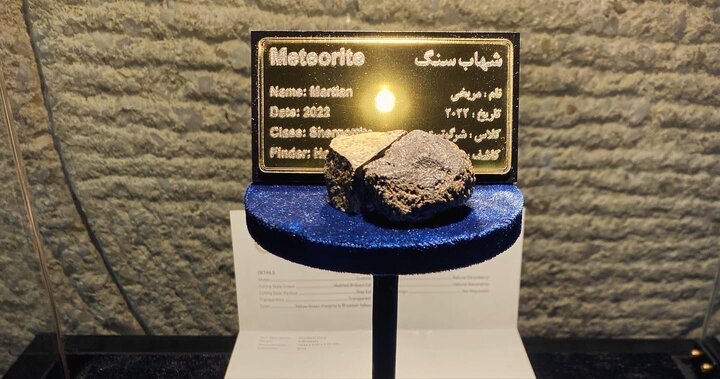Rare Martian meteorites put on view at Tehran exhibit

TEHRAN – On Tuesday, two Martian meteorites were put on show following an unveiling ceremony held at the Azadi Tower’s Meteorite Museum in Tehran.
The ceremony was attended by a number of key figures in science and culture as well as Hojjat Kamali, the museum director, who is a record holder spotter, and collector of such outer space rocks, Mehr reported.
Addressing the event, Kamali shared details about the Martian meteorites, emphasizing their uniqueness and recent origin, estimating their age to be under 100 years.
“The authenticity of these specimens has been confirmed by France’s CEREGE (European Research and Education Centre), earning them a spot in the world’s registry.”
Highlighting the global significance of this achievement, Kamali stated that the international recognition of Iranian Martian meteorites would elevate Iran’s position in the scientific community worldwide.
Moreover, the event extended beyond Martian marvels, as a rare and precious gemstone named Alexandrite was also unveiled. Noted as one of the world’s most expensive jewels, Alexandrite’s distinguishing feature is its color-changing property under different light conditions and viewing angles.
According to organizers, exhibiting hues of emerald green, purple, blue, gray, yellow, pink, and red, Alexandrite caters to collectors’ tastes for exceptionally rare and valuable gemstones.
The museum features over 1200 meteorites, mostly collected from the UNESCO-designated Lut and other scorching Iranian deserts.
Meteorites, whether more iron-rich or “stony,” are generally silvery or black, and therefore stand out in two major environments – sandy deserts, or icy realms. According to experts, the dry conditions of a desert help to preserve the space rocks in as original a condition as possible.
Martian meteorites
A Martian meteorite is a rock that originated on Mars, having been expelled from the planet due to an impact event. It subsequently traversed interplanetary space before finally landing on Earth as a meteorite.
As of September 2020, a total of 277 meteorites have been identified as Martian, constituting less than half a percent of the 72,000 classified meteorites. The largest complete, uncut Martian meteorite, Taoudenni 002, was discovered in Mali in early 2021, weighing 14.5 kilograms. It is currently showcased at the Maine Mineral & Gem Museum.
Martian meteorites fall into three categories: shergottites, nakhlites, and chassignites, collectively referred to as SNC meteorites. Additionally, there are several ungrouped Martian meteorites. These meteorites are considered Martian due to their elemental and isotopic compositions, which closely resemble the rocks and atmospheric gases found on Mars. These compositions have been measured by orbiting spacecraft, surface landers, and rovers.
AFM
